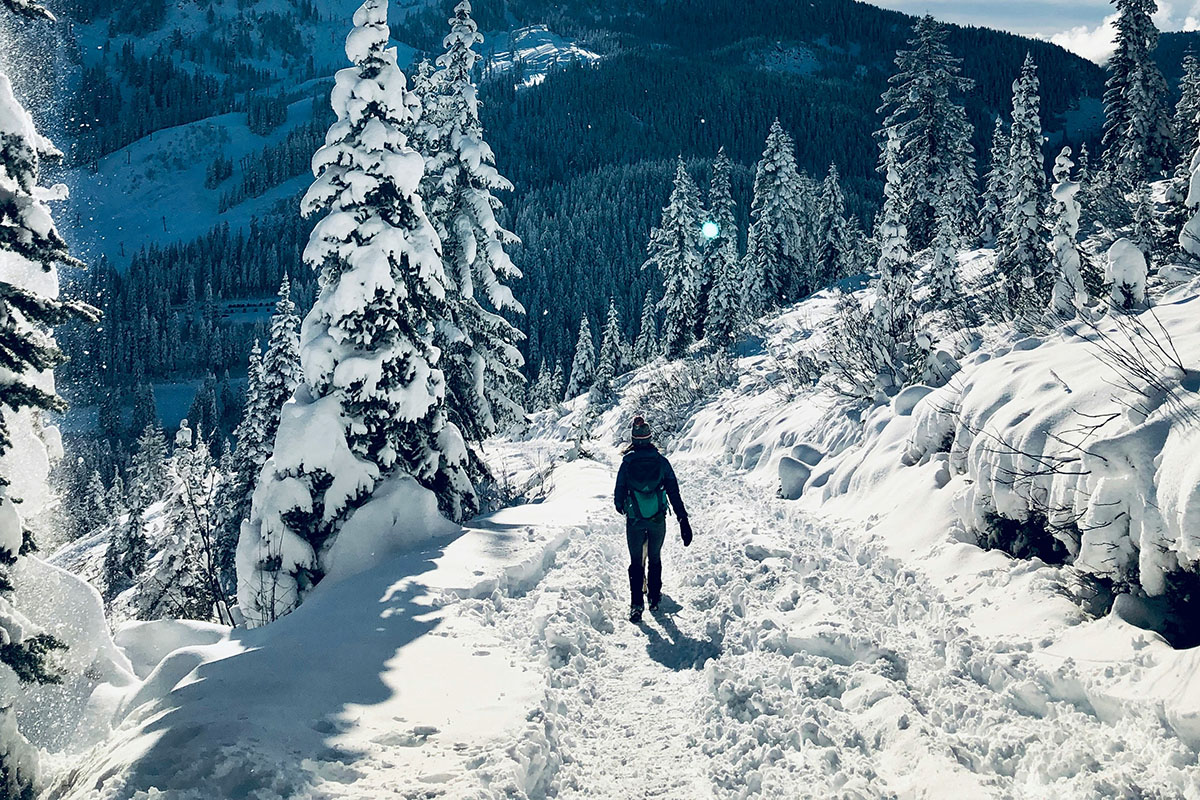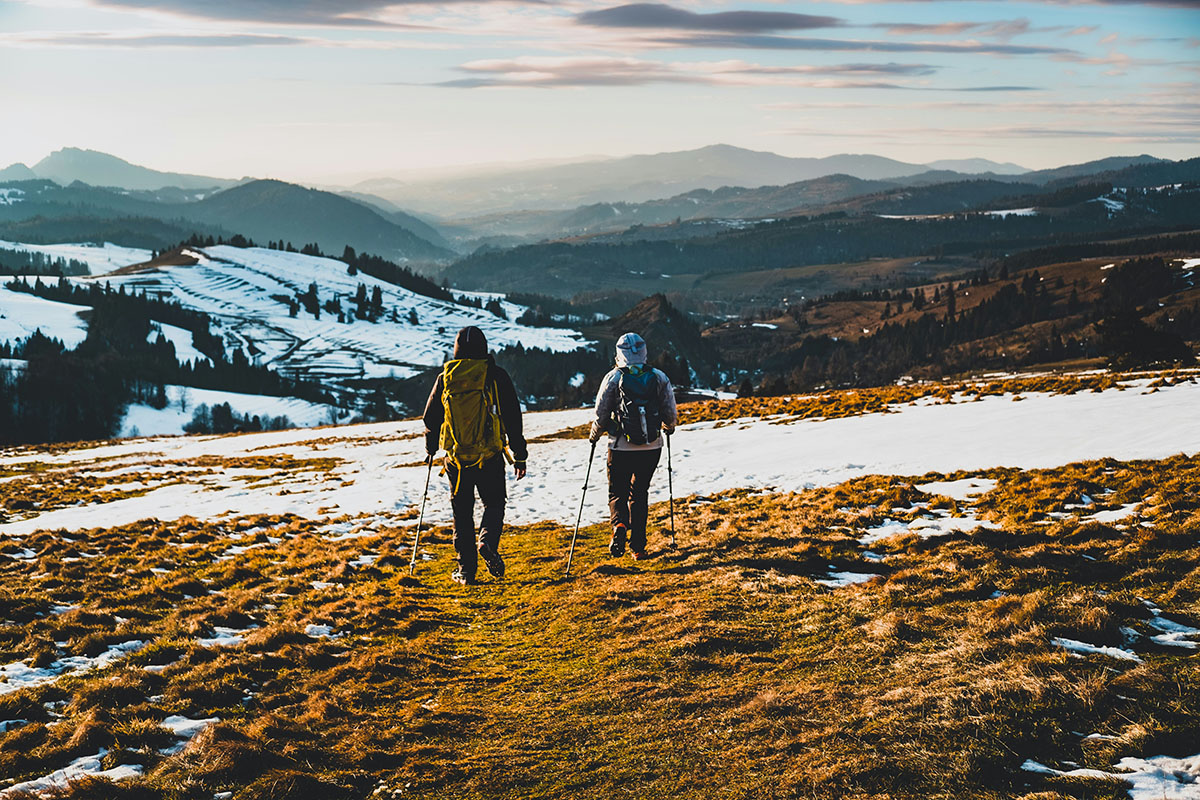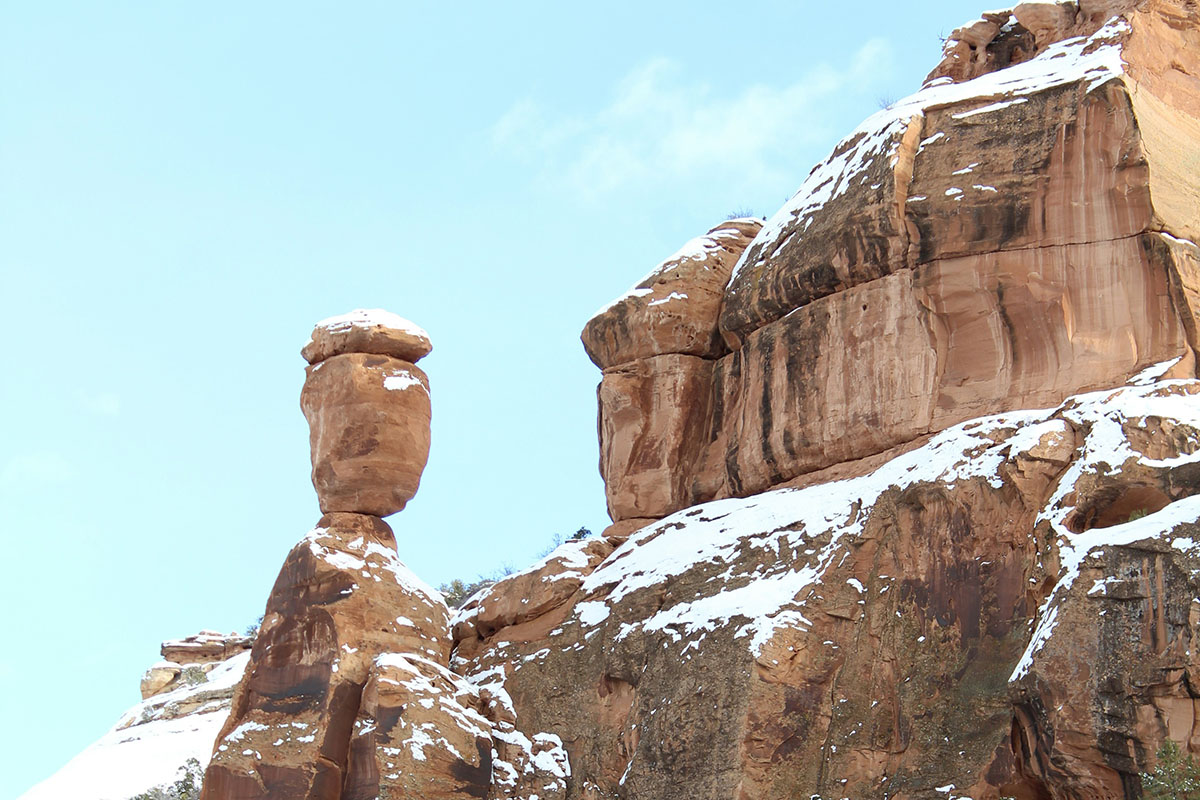

Just because the weather is a little chilly doesn’t mean the hiking season is over. In the winter months, you can spend a day exploring deserted snowscapes or discovering new places that might be off-limits in the summer heat.
Videos by Outdoors with Bear Grylls
Once you embrace the cold air on a brisk walk somewhere beautiful, you’ll understand why we love winter hiking.
Wearing the correct winter hiking clothes will make your day on the trails much more enjoyable. A layering system is vital for staying warm and comfortable during a winter hike. The key is to manage moisture, trap heat, and protect against wind and precipitation.
Before you set off, make sure you check the weather forecast in advance to see which layers are appropriate for your hiking destination. Remember, it’s easy to remove a layer, but you can’t conjure one out of thin air.
Preparing for Cold Weather
What counts as cold weather? It’s wise to prepare for all eventualities. Check the temperature before your day hike to see how many layers you will need to be comfortable. You might expect temperatures in these ranges:
- Cold temperatures range from 35°F to 50°F (1-10° C)
- Extra cold temperatures range from 20°F to 35°F (-6-1° C)
How to Layer for Day Hike in Winter and Cold Weather

Your layering system should include a selection of the following clothes.
Base Layer
The base layer is the innermost layer that is worn closest to the skin.
The purpose of a base layer is to wick moisture away from the body and provide insulation. Choose a material like merino wool or synthetic fabrics, such as nylon or polyester.
A base layer should have a snug fit close to the body to trap warmth. Base layers can be worn as tops or bottoms; they can include long-sleeved tops or thermal leggings.
Insulating Layer
The insulating layer provides warmth by trapping and retaining body heat to keep you warm. The best insulating layers include fleece, down, or synthetic insulated jackets. These materials are lightweight but will keep you very cozy when you’re out winter hiking.
A down jacket offers excellent warmth. The insulation is made from duck and goose feathers. A synthetic jacket offers another option for your layering system, with quick-drying and water-resistant properties. These types of jackets are often packable and a packable jacket is easy to carry and ideal for day hiking.
The weather conditions and your planned level of activity will determine how thick this layer should be. If you will be active, choose a lighter layer so you can better regulate your temperature.
Mid-Layer
Depending on the temperature, you may need an additional mid-layer between the base layer and the insulating layer. A fleece or softshell jacket can provide some extra insulation for hiking in the winter months. If you get too warm, you can always remove a layer.
A vest might fit the bill for a mid-layer. Here are our top picks for best men’s vests.
Outer Layer (Shell)
An outer layer or shell is the final layer of clothing in your system. It serves as a barrier against wind, rain, and snow.
A hardshell rain jacket or hiking jacket is fully waterproof and can keep you dry in harsh weather conditions. Look for hardshell rain jackets featuring membranes made from GoreTex—a waterproof, windproof, and breathable material. It can prevent overheating and allow moisture to escape.
A softshell jacket can also provide some protection as an outer layer against rain and wind, but not to the same extent as a hardshell jacket. Softshell jackets are great for mobility and comfortable to wear.
Down jackets can also work well as an outer shell in chilly weather. Some down jackets include a DWR (durable water repellent) coating to protect you from rain, but they are designed to provide optimum warmth rather than rain protection.
The outer layer should be lightweight, so it can be removed to suit the conditions you are experiencing.
Lower-Body Protection
A decent pair of hiking pants, winter hiking pants, or rain pants will protect your lower body from the cold and rain. Strong materials, such as ripstop nylon, offer abrasion resistance and can protect your legs from scratches as you explore.
For extra warmth in extremely cold weather, you might also consider wearing thermal leggings underneath your hiking pants.
Consider rain pants with ventilation zips for increasing airflow and regulating temperature, and check that the pants have secure pockets for important items.
Headwear
Wearing a hat serves several important purposes, especially when you are exploring the outdoors in winter conditions. A hat that covers your ears is essential for retaining body heat. A beanie or a balaclava can provide additional protection.
Even for winter hikes, it’s important to protect your face from the sun, so consider a hat with a visor or brim if you will be exposed to UV sunlight. Always wear SPF on any exposed skin, even when the sun is low in the sky.
Gloves and Mittens
There’s nothing more unpleasant than having cold hands. It can be uncomfortable, but also dangerous in the winter. Choose insulated, waterproof gloves or mittens to keep your hands warm and dry.
Footwear
A good pair of insulated and waterproof winter hiking boots with good traction is crucial for hiking in the winter. The conditions you may encounter during winter hiking, such as snow, ice, and cold temperatures, will require you to wear appropriate footwear.
Consider boots with insulating properties, such as Thinsulate or synthetic insulation, to avoid getting cold toes. Look for boots with good traction over rough terrain, with rubber outsoles and tread patterns designed for winter conditions.
Check that the boots offer waterproof protection to keep your feet dry. Add gaiters if you will exploring areas with deep snow to keep the snow out of your boots. Gaiters will provide an extra barrier of protection for your feet and lower legs.
Socks
Always wear comfortable socks with your hiking boots for added cushioning and warmth. Winter socks made from wool are a popular choice for hiking because they wick away moisture and help prevent blisters.
Wool socks also regulate temperature and keep your feet dry and warm.
Accessories
Accessories can increase your comfort level on a chilly day hike in the winter. For instance, consider adding a neck gaiter or a scarf for extra neck and face protection.
Don’t forget sunglasses to protect your eyes from the glare of the snow or low-level sun. Finally, hand warmers or heated insoles can be useful additions for extra warmth.
Winter Hiking Clothes
Your winter hiking clothes should offer you the weather protection you require for your day out on the trails. You will also need to take a backpack with you, so you can always fling an extra layer or two in the pack if you need to.
While you are conquering uphill sections, raising your heart rate and body temperature, you will likely need to adjust your layers as you go along. Remove layers if you start to overheat and add layers during breaks or when the temperature drops.
Remember, it’s crucial to stay dry and warm without overheating, so adjust your layers accordingly as you hike and encounter different conditions.
Where to Go Winter Hiking

Hiking is not just a summer activity. Magical winter wonderlands await during the coldest time of the year.
It can be a quieter time to visit some busy tourist spots, such as Big Bend National Park or Joshua Tree National Park. It’s actually a better time of year to visit desert landscapes, which can be unbearably hot to visit in the summer.
Winter is a wonderful season to explore diverse landscapes. Spend a day hiking through snow-capped peaks at the Great Smoky Mountains or White Mountains in New Hampshire.
Winter in Yellowstone is a unique time of year to witness America’s first national park. You can see geothermal features set against a snowy backdrop or photograph their famous bison in an incredible winter setting.
There are many accessible day hikes to enjoy in the winter that do not require ice crampons or snow shoes to get around unless that’s the winter adventure you’re looking for. Discover more bucket list hikes for the winter.
Also check out our winter hiking tips and essential gear guide.









